The Story of Oklahoma City
I'd planned, and intended, to do this post on my blog's 3rd birthday, July 15, 2009 ... and give you my birthday present then. But, if you are like me, when I have a great present to give, it messes my head up if any measure of restraint on the time of giving must be observed. So I'm blowing-off the restraint factor (it's my party and I can do what I want) and you get it now, an early birthday present.
Sooo ... what's your present?
I have finished the process of scanning and converting to multiple html pages, and to a single PDF file, a marvelous little book, The Story of Oklahoma City by Angelo C. Scott (Times-Journal Publishing Co. 1939) which I've owned for some time but which until recently I'd hardly bothered to open, much less read. But, now, I have. And, since the Times-Journal Publishing Co. which owns the copyright no longer exists, I presume that this vintage book is in the public domain and that re-publication here involves no copyright-infringement issues. Hence, in this article, you get the extra-large-real-meal-deal but without coke or fries.
Just the book. All of the book.
Click here to jump ahead read about the author. But, immediately below, click on the graphic to begin reading what you want in this amazing view of early Oklahoma City, mostly covering its first decade or so, which was written by an educated man from Iola, Kansas, himself a participant in the April 22, 1889, Land Run. I've also made a bookmarked PDF file. At 39.4 MB, it's a large file and unless you are on a broadband connection I don't recommend that you try to open or download it ... but for those that want it, the PDF file is at this location.
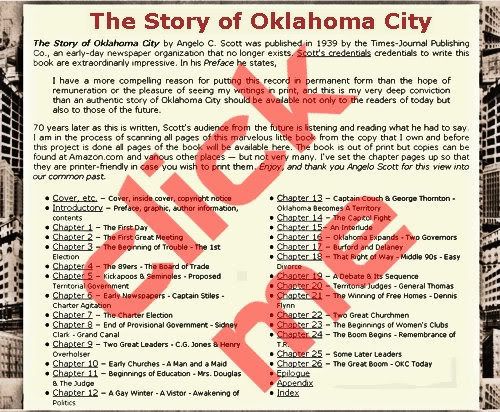 .
.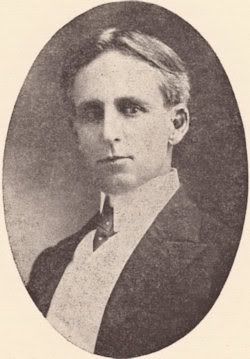 About The Author. Angelo C. Scott was born September 25, 1857, near Franklin, Indiana, but, prior to the April 22, 1889, Land Run, he must be regarded as a Kansan. After his death in Oklahoma City on February 6, 1949, his remains were buried in Highland Cemetery in Iola, Kansas, but, it was during his time in Oklahoma and Oklahoma City that he made his mark. It is clear from this book that he regarded himself as a Oklahoman — in the book, his dedication page reads, "This book is dedicated to my fellow pioneers of eighteen-hundred and eighty-nine." Kansas got his remains, but Oklahoma got his life.
About The Author. Angelo C. Scott was born September 25, 1857, near Franklin, Indiana, but, prior to the April 22, 1889, Land Run, he must be regarded as a Kansan. After his death in Oklahoma City on February 6, 1949, his remains were buried in Highland Cemetery in Iola, Kansas, but, it was during his time in Oklahoma and Oklahoma City that he made his mark. It is clear from this book that he regarded himself as a Oklahoman — in the book, his dedication page reads, "This book is dedicated to my fellow pioneers of eighteen-hundred and eighty-nine." Kansas got his remains, but Oklahoma got his life.At page 58, Scott presents this picture of himself during the time that he was president of A & M College during 1899-1908(Oklahoma State University).
Another (much smaller) image of him can be seen at the OSU website where he is shown as the 5th president of the school.
Angelo C. Scott and his brother W.W. Scott established and published Oklahoma City's very first newspaper, initially named the Oklahoma Times. The 1st publication date was May 9, 1889. Another paper, not yet located in Oklahoma City but started at Wichita, was named the Oklahoma City Times. Confusion over identity led the Oklahoma Times to change its name to the Times-Journal shortly thereafter. See Chapter 6 in Scott's book for more about that.
Eventually, the Times-Journal was sold and it eventually became the Oklahoma City Times, even though the Times-Journal Publishing Company retained its commercial printing department and that now defunct organization was the publisher of Angelo Scott's 1939 book.
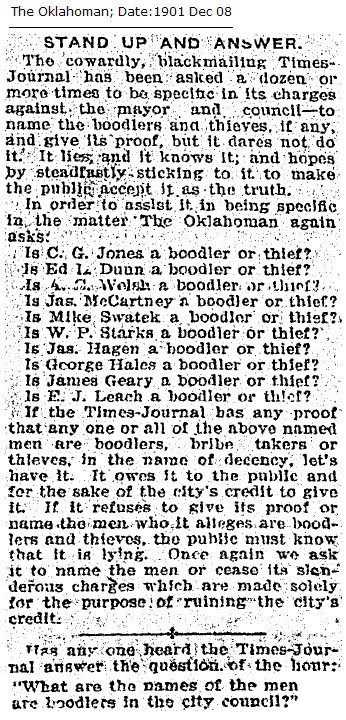 Although I've hardly begun to study the matter, apparently the Times-Journal and the Daily Oklahoman newspapers were at each other's throat in those days, and the banter which was engaged by the two papers was, shall we say, feisty.
Although I've hardly begun to study the matter, apparently the Times-Journal and the Daily Oklahoman newspapers were at each other's throat in those days, and the banter which was engaged by the two papers was, shall we say, feisty. Click on the December 8, 1901, article at the right for a few more Daily Oklahoman illustrations.
Unfortunately, the long-defunct Times-Journal's issues are not available on-line and, one of these days, I'll venture to the Oklahoma History Center to see (hopefully) its take on what the Times-Journal had to say about the Daily Oklahoman — and that should result in a terrifically fun, probably hilarious, article in its own right. But, not today.
Angelo Scott was much more than the co-founder of Oklahoma City's first newspaper. The on-line Oklahoma History Center's Encyclopedia of Oklahoma History & Culture, Carolyn G. Hanneman wrote this about the book's author:
SCOTT, ANGELO CYRUS (1857-1949)Hopefully, Ms. Hanneman got most of the facts right, but if you've been a diligent reader of Doug Dawgz Blog you know that Epworth University closed its doors in Oklahoma City in 1911 and that the Methodists established a new college in Guthrie (The Methodist University of Oklahoma) ... which itself closed its doors in 1919 ... and that a distinctly new Oklahoma City College/University was established here in that same year and it was NOT named Epworth University. In case you missed it (Epworth is one of the mini-articles buried within the Vintage Map collection), see the Vintage Map Index) and click on this article about that. Also, compare the article's "Epworth" and "OCU" history with that given by Scott himself in the book, below. More significantly, the Oklahoma Historical Society article does not even note that Scott wrote this fine history of Oklahoma City, published in 1939. No "two thumbs up" for you, OHC, on such a glaring omission as well as rather completely inaccurate reporting about Epworth and Oklahoma City University.
Oklahoma educator and civic leader Angelo C. Scott, son of John W. and Maria Protsman Scott, was born on September 25, 1857, near Franklin, Indiana. Educated in Kansas public schools and by private tutors, he completed the bachelor's (1877) and master's (1880) degrees at the University of Kansas. He taught in the Kansas public schools for three years and was elected court clerk of Allen County, Kansas. In 1885 he obtained two law degrees from George Washington University and returned to Iola, Kansas, to practice law.
Scott came to Oklahoma Territory (O.T.) in the Land Run of 1889. As one of the original Oklahoma City settlers, he opened a law office and operated a hotel. With his brother, he founded Oklahoma City's first newspaper, the Oklahoma Times. Scott helped organize the Oklahoma City Chamber of Commerce, the Oklahoma City Young Men's Christian Association, and the Men's Dinner Club. He was a charter member of the First Presbyterian Church and founded the Oklahoma Institute of Arts and Sciences.
Pres. Benjamin Harrison appointed Scott to the Oklahoma City town site board to handle land claim disputes in 1890. From 1891 to 1892 he served as United States Commissioner for O.T. In 1893 Gov. Abraham J. Seay appointed him Oklahoma's executive commissioner to the Columbian Exposition in Chicago. After marrying Lola Smeltzer in 1894, Scott was elected to the territorial senate and served as president pro tempore from 1895 to 1897. Defeated for reelection, he accepted an invitation to teach English and literature at Oklahoma A&M College (now Oklahoma State University).
In 1899 Scott became president of the college. Although he believed in the school's land-grant mission of emphasizing agriculture and engineering, he was not an agriculturalist. He wanted to develop a liberal arts curriculum to widen the institution's appeal. During his nine-year presidency the college grew with the construction of several buildings and the doubling of faculty, which was said to be unexcelled by any land-grant college in the region. Scott coached the oratory teams and with his wife established an informal music department. He also encouraged the development of athletics and wrote the first college fight song.
When Oklahoma citizens elected a full slate of Democratic officials in 1907, Scott was told that all Republican appointees would lose their jobs. He resigned on June 30, 1908, and returned to Oklahoma City to practice law. He soon accepted the chairmanship of the University of Oklahoma (OU) English department but before starting the job resigned to accept a professorship in English at Epworth University (now Oklahoma City University). From 1913 to 1923 he was director of OU extension lectures. In 1923 he returned to Epworth to chair the English department until his retirement in 1931. [Ed. note: this is at least partially incorrect - see the note below].
Scott wrote numerous articles, brochures, and books, including a textbook, Practical English (1908). Inducted into the Oklahoma Hall of Fame (1933), he was named Oklahoma City's Most Useful Citizen (1937) and received the University of Kansas Alumni Association Distinguished Service Award (1946). He also held an honorary doctorate of letters from Emporia College in Kansas. Scott died on February 6, 1949, in Oklahoma City and was interred in Highland Cemetery, in Iola, Kansas.
At page 197 of the book, Scott gives this description of himself:
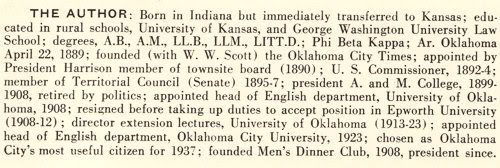
Premier Oklahoma historian Bob Blackburn in his book Heritage Hills (Western Heritage Books 1990) said this about Scott's book:
Angelo added to his contributions by writing one of the most touching histories of Oklahoma City ever published.I would only add to that by saying, "Amen, Brother Bob!" The book is a charmer.
At page 152, Blackburn's book also shows the home that Angelo and his wife Lola built in 1915 at 310 N.W. 16th, and where they lived until Scott's death in 1948, followed by his wife eight years later.
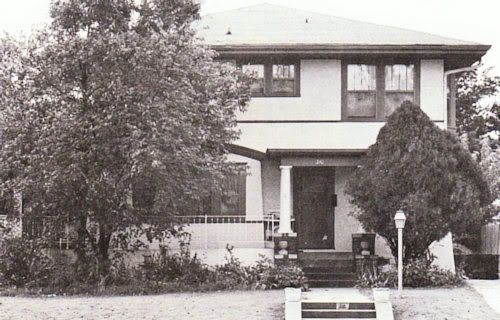
Go To Top














2 comments:
Hi - The Brown family is my family and my 2nd Great Uncle was Elmer Brown who is mentioned in the book. A lot of the story of the newspaper and publishing company has been lost to time so I appreciate the info. I wish we still owned the publishing bit! Lewis was a brother of Elmers' and all the brothers at one time or another either worked or a family member worked at the paper or the publishing company. Thank you again from the Brown family!
I actually bought this book and read a physical copy before realizing you had this uploaded online. But it really is an amazingly written book by somebody who witnessed a lot of events first hand. Scott's modern sensibilities make this text more accessible to the modern reader, I think. Thanks so much for making it publicly available.
Post a Comment